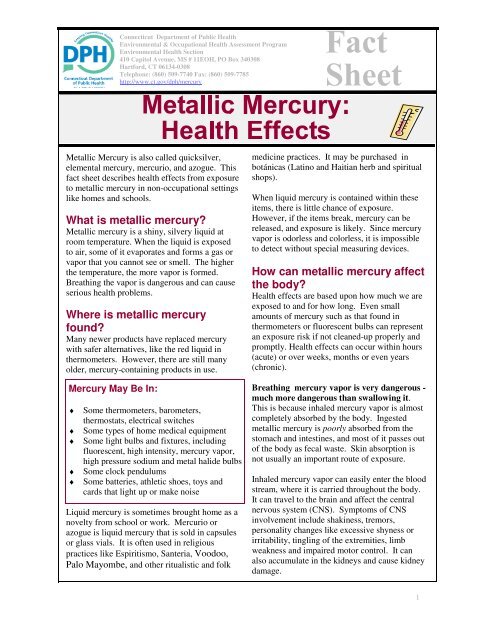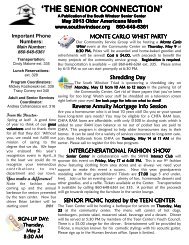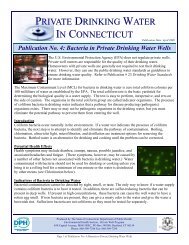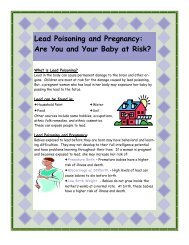Metallic Mercury: Health Effects Fact Sheet - CT.gov
Metallic Mercury: Health Effects Fact Sheet - CT.gov
Metallic Mercury: Health Effects Fact Sheet - CT.gov
Create successful ePaper yourself
Turn your PDF publications into a flip-book with our unique Google optimized e-Paper software.
Connecticut Department of Public <strong>Health</strong><br />
Environmental & Occupational <strong>Health</strong> Assessment Program<br />
Environmental <strong>Health</strong> Section<br />
410 Capitol Avenue, MS # 11EOH, PO Box 340308<br />
Hartford, <strong>CT</strong> 06134-0308<br />
Telephone: (860) 509-7740 Fax: (860) 509-7785<br />
http://www.ct.<strong>gov</strong>/dph/mercury<br />
<strong>Metallic</strong> <strong>Mercury</strong> is also called quicksilver,<br />
elemental mercury, mercurio, and azogue. This<br />
fact sheet describes health effects from exposure<br />
to metallic mercury in non-occupational settings<br />
like homes and schools.<br />
What is metallic mercury?<br />
<strong>Metallic</strong> mercury is a shiny, silvery liquid at<br />
room temperature. When the liquid is exposed<br />
to air, some of it evaporates and forms a gas or<br />
vapor that you cannot see or smell. The higher<br />
the temperature, the more vapor is formed.<br />
Breathing the vapor is dangerous and can cause<br />
serious health problems.<br />
Where is metallic mercury<br />
found?<br />
Many newer products have replaced mercury<br />
with safer alternatives, like the red liquid in<br />
thermometers. However, there are still many<br />
older, mercury-containing products in use.<br />
<strong>Mercury</strong> May Be In:<br />
♦<br />
♦<br />
♦<br />
♦<br />
♦<br />
Some thermometers, barometers,<br />
thermostats, electrical switches<br />
Some types of home medical equipment<br />
Some light bulbs and fixtures, including<br />
fluorescent, high intensity, mercury vapor,<br />
high pressure sodium and metal halide bulbs<br />
Some clock pendulums<br />
Some batteries, athletic shoes, toys and<br />
cards that light up or make noise<br />
Liquid mercury is sometimes brought home as a<br />
novelty from school or work. Mercurio or<br />
azogue is liquid mercury that is sold in capsules<br />
or glass vials. It is often used in religious<br />
practices like Espiritismo, Santeria, Voodoo,<br />
Palo Mayombe, and other ritualistic and folk<br />
medicine practices. It may be purchased in<br />
botánicas (Latino and Haitian herb and spiritual<br />
shops).<br />
When liquid mercury is contained within these<br />
items, there is little chance of exposure.<br />
However, if the items break, mercury can be<br />
released, and exposure is likely. Since mercury<br />
vapor is odorless and colorless, it is impossible<br />
to detect without special measuring devices.<br />
How can metallic mercury affect<br />
the body?<br />
<strong>Health</strong> effects are based upon how much we are<br />
exposed to and for how long. Even small<br />
amounts of mercury such as that found in<br />
thermometers or fluorescent bulbs can represent<br />
an exposure risk if not cleaned-up properly and<br />
promptly. <strong>Health</strong> effects can occur within hours<br />
(acute) or over weeks, months or even years<br />
(chronic).<br />
Breathing mercury vapor is very dangerous -<br />
much more dangerous than swallowing it.<br />
This is because inhaled mercury vapor is almost<br />
completely absorbed by the body. Ingested<br />
metallic mercury is poorly absorbed from the<br />
stomach and intestines, and most of it passes out<br />
of the body as fecal waste. Skin absorption is<br />
not usually an important route of exposure.<br />
Inhaled mercury vapor can easily enter the blood<br />
stream, where it is carried throughout the body.<br />
It can travel to the brain and affect the central<br />
nervous system (CNS). Symptoms of CNS<br />
involvement include shakiness, tremors,<br />
personality changes like excessive shyness or<br />
irritability, tingling of the extremities, limb<br />
weakness and impaired motor control. It can<br />
also accumulate in the kidneys and cause kidney<br />
damage.<br />
1
♦<br />
♦<br />
♦<br />
♦<br />
Long-Term (Chronic) Exposure<br />
Shakiness<br />
Psychological<br />
changes<br />
Difficulty sleeping<br />
Loss of appetite<br />
with weight loss<br />
♦<br />
♦<br />
♦<br />
♦<br />
♦<br />
Irritability<br />
Excessive shyness<br />
Emotional instability<br />
Headache<br />
Short-term memory<br />
loss<br />
Fetal exposure is of particular concern because<br />
mercury can become trapped in the developing<br />
brain. This impairs brain development, and<br />
effects may show up months to years after the<br />
exposure stops.<br />
<strong>Metallic</strong> mercury vapor may irritate the lining of<br />
mouth and lungs. This can cause a metallic taste<br />
in the mouth, chest tightness, cough, and burning<br />
sensation in the lungs. These symptoms can<br />
either be from short term exposure to high levels<br />
of mercury vapor (hours), or from longer term<br />
exposure to low levels over weeks or months.<br />
Other symptoms of exposure include nausea,<br />
vomiting, diarrhea, increases in blood pressure or<br />
heart rate, skin rashes, and eye irritation.<br />
Who is at highest risk?<br />
Children and pregnant women are at highest risk<br />
if exposed, because the central nervous system is<br />
not fully matured in children and fetuses . Also,<br />
since mercury vapor is heavier than air, it tends to<br />
settle to the floor. This puts children at increased<br />
risk, because they are closer to the ground and are<br />
more likely to breathe mercury vapor which has<br />
settled. They also tend spend more time sitting or<br />
lying on carpets or other flooring. Children<br />
exposed to mercury for long periods of time may<br />
develop a disorder called acrodynia, or pink<br />
disease. This looks like an abnormal red rash<br />
with peeling of hands, nose, and soles of the<br />
feet. Other symptoms may follow, including<br />
excessive sweating or drooling, fretfulness,<br />
weakness, sleeplessness, irritability, fast heart<br />
rate, or increased blood pressure. Rarely,<br />
acrodynia can occur in teens and adults.<br />
What if I was exposed or have<br />
symptoms?<br />
If you or other household occupants have been<br />
exposed to mercury and are experiencing any<br />
symptoms described in this handout, contact<br />
your doctor. Be sure to tell him/her about<br />
your exposure to metallic mercury. There are<br />
laboratory tests that can help evaluate your<br />
level of exposure. Your doctor can order a<br />
urine mercury level to evaluate long-term<br />
exposure. A blood test is sometimes done to<br />
evaluate high-level, short-term exposures.<br />
However, these tests are not recommended for<br />
most home, school, or office exposures.<br />
What about treatment?<br />
Medical treatment is not needed for most of the<br />
exposures from spills in homes or schools that<br />
come from small quantities of mercury (like<br />
broken thermometers or fluorescent bulbs). If<br />
you are exposed to large amounts, or your<br />
exposure lasts for weeks, months, or years, you<br />
should talk to your doctor about treatment<br />
options.<br />
More <strong>Mercury</strong> Information<br />
For information about cleaning up broken<br />
thermometers or compact fluorescent bulbs<br />
(CFLs), mercury action levels for indoor spills,<br />
and spill response in schools, please visit the<br />
<strong>CT</strong> DPH website:<br />
http://www.ct.<strong>gov</strong>/dph/mercury<br />
Important Phone Numbers<br />
<strong>CT</strong> Dept. Public <strong>Health</strong><br />
Environmental & Occupational <strong>Health</strong> Assessment Program<br />
860-509-7742<br />
<strong>CT</strong> Poison Control Center 800-343-2722<br />
<strong>CT</strong> Dept Environmental Protection<br />
Emergency Spills (24/7)<br />
UCONN <strong>Health</strong> Center<br />
Occupational & Environmental Medicine Clinic<br />
860-424-3338<br />
866-337-7745 (toll free)<br />
860-679-2893<br />
Yale Occupational & Environmental Medicine Clinic 203-785-4197<br />
September 2009 2














